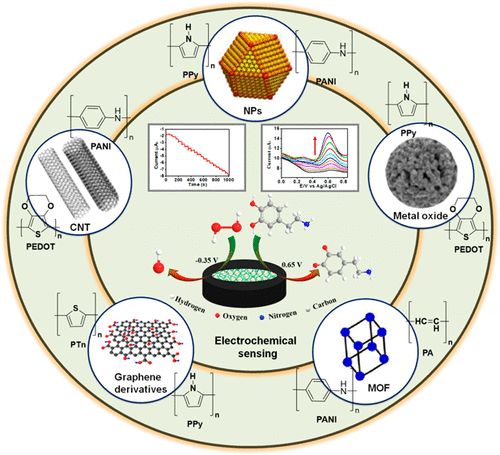当前位置:
X-MOL 学术
›
Ind. Eng. Chem. Res.
›
论文详情
Our official English website, www.x-mol.net, welcomes your
feedback! (Note: you will need to create a separate account there.)
Recent Advances on Conducting Polymer-Supported Nanocomposites for Nonenzymatic Electrochemical Sensing
Industrial & Engineering Chemistry Research ( IF 3.8 ) Pub Date : 2021-09-08 , DOI: 10.1021/acs.iecr.1c02043 Shamim Ahmed Hira 1 , Mohammad Yusuf 1 , Dicky Annas 1 , Saravanan Nagappan 1 , Sehwan Song 2 , Sungkyun Park 2 , Kang Hyun Park 1
Industrial & Engineering Chemistry Research ( IF 3.8 ) Pub Date : 2021-09-08 , DOI: 10.1021/acs.iecr.1c02043 Shamim Ahmed Hira 1 , Mohammad Yusuf 1 , Dicky Annas 1 , Saravanan Nagappan 1 , Sehwan Song 2 , Sungkyun Park 2 , Kang Hyun Park 1
Affiliation

|
Polymer nanocomposites exhibit idiosyncratic physicochemical features that cannot be achieved by the respective individual constituting materials. Owing to their unique properties, they have witnessed widespread application in numerous areas of electrochemistry such as supercapacitors, batteries, solar cells, energy storage, and electrochemical sensors. By combining polymeric materials such as polyaniline (PANI), polyacetylene (PAc), polypyrrole (PPy), polythiophene (PTn), or poly(3,4-ethylenedioxythiophene) (PEDOT) with different fillers, for example, carbon nanotubes (CNTs), graphene (Gpn), metal nanoparticles (MNPs), and metal–organic frameworks (MOFs), several composites materials have been fabricated. Electrochemical sensors are very selective, sensitive, and low-cost materials for the effective detection of target molecules. This review summarizes some conventional conducting polymer-based nanocomposites and their utility as electrochemical sensors. Lastly, a discussion on the future perspectives of conducting polymer nanocomposites is also included.
中文翻译:

用于非酶电化学传感的导电聚合物负载纳米复合材料的最新进展
聚合物纳米复合材料表现出独特的物理化学特征,这是各个单独的构成材料无法实现的。由于其独特的性质,它们在电化学的众多领域得到了广泛的应用,如超级电容器、电池、太阳能电池、储能和电化学传感器。通过将诸如聚苯胺 (PANI)、聚乙炔 (PAc)、聚吡咯 (PPy)、聚噻吩 (PTn) 或聚 (3,4-乙撑二氧噻吩) (PEDOT) 等聚合物材料与不同的填料(例如碳纳米管 (CNT))结合使用、石墨烯(Gpn)、金属纳米粒子(MNPs)和金属有机骨架(MOFs),已经制造了几种复合材料。电化学传感器是用于有效检测目标分子的选择性、灵敏和低成本的材料。本综述总结了一些传统的基于导电聚合物的纳米复合材料及其作为电化学传感器的用途。最后,还讨论了导电聚合物纳米复合材料的未来前景。
更新日期:2021-09-22
中文翻译:

用于非酶电化学传感的导电聚合物负载纳米复合材料的最新进展
聚合物纳米复合材料表现出独特的物理化学特征,这是各个单独的构成材料无法实现的。由于其独特的性质,它们在电化学的众多领域得到了广泛的应用,如超级电容器、电池、太阳能电池、储能和电化学传感器。通过将诸如聚苯胺 (PANI)、聚乙炔 (PAc)、聚吡咯 (PPy)、聚噻吩 (PTn) 或聚 (3,4-乙撑二氧噻吩) (PEDOT) 等聚合物材料与不同的填料(例如碳纳米管 (CNT))结合使用、石墨烯(Gpn)、金属纳米粒子(MNPs)和金属有机骨架(MOFs),已经制造了几种复合材料。电化学传感器是用于有效检测目标分子的选择性、灵敏和低成本的材料。本综述总结了一些传统的基于导电聚合物的纳米复合材料及其作为电化学传感器的用途。最后,还讨论了导电聚合物纳米复合材料的未来前景。











































 京公网安备 11010802027423号
京公网安备 11010802027423号